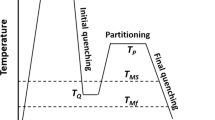Abstract
One purpose of thermomechanical treatment of steels, for example the control rolling of plate, is to produce the finest uniform microstructure in the product to optimize its strength and toughness. To achieve this end requires control of the structual changes that occur during reheating, high-temperature (roughing) deformation, lower temperature (finishing) deformation, and austenite transformation. A study has been made of the effects of the deformation processing variables on the microstructural changes that occur in high-strength low-alloy (HSLA) steels in the temperature ranges in which complete, partial, or no recrystallization occurs. The experimental technique comprised a sequence of plane-strain compressions of specimens being cooled at rates controlled to simulate the rate of cooling of slabs being rolled to plates. The results show that in the complete recrystallization range a fixed pass schedule refines the initial grain sizes in steels of a wide range of compositions and initial grain sizes to about the same final size; the final recrystallized grain size decreases with deformation temperature (within the complete recrystallization range), increasing strain rate, and increasing draft,i.e., with any deformation parameter that increases flow stress; the solute content and initial grain size, which are fixed by reheat temperature, control the temperature at which complete recrystallization stops during hot rolling. Deformation in the “partial recrystallization” range causes duplexing in the austenite that cannot be removed by subsequent rolling, consequently rolling in this range should be avoided. During finishing, the height of the flattened austenite grains decreases with increasing finishing reduction, but at a rate less than the rate of decrease of specimen height, indicating that some recovery is occuring. The grain diameter of the ferrite formed from fine, elongated austenite is about half the austenite grain-boundary separation (measured in the throughthickness direction) indicating that the elongated boundaries are the primary nucleation sites for ferrite.
Similar content being viewed by others
References
L. J. Cuddy, J. J. Bauwin, and J.C. Raley:Metall. Trans. A, 1980, vol. 11 A, p. 381.
T. Gladman:Proc. R. Soc, 1966, vol. 294 A, p. 298.
T. Tanaka, T. Funakoshi, M. Veda, J. Tsuboi, T. Yasuda, and C. Utahashi:Micro Alloying ’75, p. 399, Union Carbide Corp., New York, 1977.
H. J. McQueen and J. J. Jonas:Treatise on Materials Science and Technology, vol. 6, p. 394, Academic Press, 1975.
R. Priestner, C. C. Early, and J. H. Rendall:J. Iron Steel Inst., 1968, vol. 206, p. 1252.
H. Sekine and T. Marujama:Microstructure and Design of Alloys, vol. 1, p. 85, Metals Society, London, 1974.
C. M.Sellars:Hot Working and Forming Processes, p. 3, Metals Society, London, 1980.
C. M. Sellars and J. A. Whiteman:Met. Sci., 1979, vol. 13, p. 187.
Author information
Authors and Affiliations
Rights and permissions
About this article
Cite this article
Cuddy, L.J. Microstructures developed during thermomechanical treatment of HSLA steels. Metall Trans A 12, 1313–1320 (1981). https://doi.org/10.1007/BF02642345
Received:
Issue Date:
DOI: https://doi.org/10.1007/BF02642345




